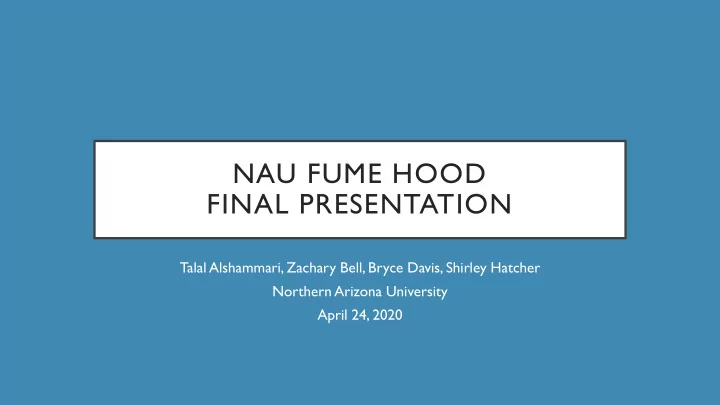

NAU FUME HOOD FINAL PRESENTATION Talal Alshammari, Zachary Bell, Bryce Davis, Shirley Hatcher Northern Arizona University April 24, 2020
PROJECT DESCRIPTION o The Project is to design a fume hood for the biomechanics lab that will be attached with an provided exhauster to be used in Carbon Fiber experiments to filter the particles produced during the experiment. o Dimensions: 4ft wide - 2ft deep – 3 ft long. o Filtering system: the filter is an essential component required by the client, which will be attached to the exhauster. o Additional Features: Pressure transducer – Visual display 2 Talal Alshammari (pres. #3) 04/24/2020
ENGINEERING REQUIREMENTS Table 1: Engineering Requirements o Engineering Requirements determined from Customer Needs. o Safe for common use at NAU’s Biomechatronics Lab o Eliminate the threats of Carbon Fiber epoxy fumes and particulates produced during sanding and cutting operations. 3 Shirley Hatcher (pres. #3) 04/24/2020
TOLERANCES Table 2: Tolerance Measurements o Tolerances determined based on relationships between pressure, velocity, and volumetric flow rate through the system. Figure 1: Dimensioned CAD Model 4 Shirley Hatcher (pres. #3) 04/24/2020
COMPUTATIONAL ANALYSIS 2000 𝑔𝑞𝑛 = 7.5 ∗ 10 −4 𝑔𝑢 3 3𝑔𝑢 2 o 𝑆𝑓𝑟𝑣𝑗𝑠𝑓𝑒 𝐵𝑗𝑠 𝐺𝑚𝑝𝑥: 𝑅 = 𝐵 [eqn. 1] 𝑤 = 𝑛𝑗𝑜 0.00075 𝑔𝑢3 o 𝑊𝑓𝑚𝑝𝑑𝑗𝑢𝑧 𝑝𝑔 𝐵𝑗𝑠 𝑗𝑜 𝐸𝑣𝑑𝑢: 𝑤 = 𝑅 𝑔𝑢 [eqn. 2] 𝑛𝑗𝑜 𝐵 = = 8.6 𝜌 4 ∗0.4𝑗𝑜 2 𝑛𝑗𝑜 o 𝐵𝑠𝑓𝑏 𝑝𝑔 𝐼𝑝𝑝𝑒 𝑃𝑞𝑓𝑜𝑗𝑜: 1.5𝑔𝑢 ∗ 2𝑔𝑢 = 3𝑔𝑢 2 [eqn. 3] 5 Shirley Hatcher (pres. #3) 04/24/2020
RISK ANALYSIS Table 3: Top 10 most important failure criterion from simplified FMEA o From this risk analysis we can prove that our biggest potential failures arise from the fume hood chamber, the exhauster fan, and the exhaustion hose. o We are focused primarily on the fume hood chamber aspect of this capstone. If the hood chamber design is unable to provide adequate suction power or falls apart it would cause usability issues for the device. As such we are less focused on the failures of the exhauster fan since this was done previously in a different capstone. 6 Bryce Davis (pres. #3) 04/24/2020
RISK ANALYSIS- CONTINUED Severity Standard Cause of Failure o Each of the top 3 o Each part failed for different reasons. potential failures would o The Exhauster hose has a potential to fail from abrasive wear as sharp carbon fiber render the fume hood particulates would cut and scrape the hose inoperable. Failures walls causing tears and suction loss. would allow harmful o The exhauster has potential to fail due to particulates and fumes thermal fatigue (overheating) due to to enter the atmosphere prolonged usage times. in the room proving o Lastly, the hood chamber would fail due to harmful to users within potential corrosion on the walls of the the lab. chamber. Carbon fiber of itself is prone to galvanic corrosion and could transfer this tendency to the chamber materials. [1] 7 Bryce Davis (pres. #3) 04/24/2020
RISK MITIGATION o From our risk analysis we came up with some possibilities that would eliminate or mitigate the main potentials causes for error within the system. o As mentioned previously, when coupled with a Carbon Component, both Aluminum and plain Steel are susceptible to galvanic corrosion. This would corrode the hood chamber, while also rendering it useless. To mitigate this potential failure we are looking into more carbon friendly hood chamber materials. This includes moldable plastics (which would be a cheaper option to metals), titanium (with it’s alloys), or even stainless steel. However, stainless steel would be more susceptible to pitting or crevice corrosion [1]. o We hope to eliminate cutting of the exhaust hose by first testing the current hose that accompanies the exhauster to see exactly how it stands up to sharp carbon fiber particles and fumes. The next step would be to replace the hose with a more durable (smooth walled) hose that could be made of a compatible metal. o To mitigate the risk of thermal fatigue and overheating we discussed, with Dr. Lerner, a relay device that would shut the exhauster fan down until it reached a cooler operating temperature. We also assume that the exhauster fan may already have this technology built in and this assumption requires further testing and analysis. 8 Bryce Davis (pres. #3) 04/24/2020
TESTING PROCEDURES o To conduct further analysis and study we hope to be able to test our exhauster and hood chamber with colored smoke or powder. This test would allow our team to conduct a series of tests including: suction power, flow rate, velocity, and particulate capture efficiency. o Testing could be done anywhere, but we hope to test at NAU’s Biomechatronics lab to get a clearer picture of how and when this device will operate in its primary habitat. 9 Bryce Davis (pres. #3) 04/24/2020
ME486 PROJECT SCHEDULE Figure 2: ME 486 Gantt Chart Schedule 10 Talal Alshammari (pres. #3) 04/24/2020
BUDGET ANALYSIS Table 4: Current Budget Analysis T otal Budget $400 Anticipated Expenses $400 Actual Expenses to Date $0 Saved Expenses $400 Remaining Balance $400 11 Talal Alshammari (pres. #3) 04/24/2020
REFERENCES o Bossard , “Galvanic Corrosion in Carbon Fiber Materials, “ 19 December 2014. [online]. Available: https://provenproductivity.com/galvanic-corrosion-carbon-fiber- materials-2/#. [Accessed 24 April 2020]. 12
Recommend
More recommend